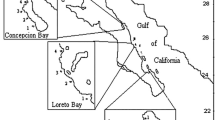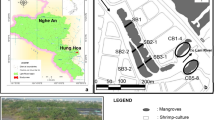Abstract
The zonation patterns ofAvicennia bicolor andRhizophora racemosa were studied in a mangrove forest on the Pacific Coast of Costa Rica. Comparisons were made between the establishment, survival, and growth of both species in three plots, 1 ha each, located along the flooding gradient. Based on cohort analysis and reciprocal planting observations, it was concluded that species zonation was primarily regulated by the depth of tidal inundation and the differential ability of the propagules to become established. However, tidal sorting was not the only operative factor related to inundation. Drought and probably high soil salinities limited the survival and growth ofR. racemosa in the landward sections of the forest. Tidal sorting, however, confined propagules to zones where they probably had the highest likelihood of contributing to another generation.
Similar content being viewed by others
Literature Cited
Ball, M. C. 1980. Patterns of secandary succession in a mangrove forest of southern Florida.Oecologia 44:226–235.
Burns, B. andJ. Ogden. 1985. The demography of the temperate mangroveAvicennia marina at its southern limit in New Zealand.Australian Journal of Ecology 10:125–133.
Clarke, L. D. andN. J. Hannon. 1971. The mangrove swamp and salt marsh communities of the Sydney district. IV. The significance of species interaction.Journal of Ecology 59:535–553.
Jiménez, J. A. 1988a Floral and fruiting phenology of trees in a mangrove forest on the dry Pacific Coast of Costa Rica.Brenesia 29:33–50.
Jiménez, J. A. 1988b. The dynamics ofRhizophora racemosa Meyer forests on the Pacific Coast of Costa Rica.Brenesia 30: 1–12.
Jiménez, J. A. 1990. The structure and function of dry weather mangroves on the Pacific Coast of Central America, with emphasis onAvicennia bicolor forests.Estuaries 13:182–192.
Pielou, E. C. 1974. Population and Community Ecology. Gordon and Breach, New York.
Rabinowitz, D. 1978a. Early growth of mangrove seedlings in Panama, and an hypothesis concerning the relationship of dispersal and zonation,Journal of Biogeography 5:113–133.
Rabinowitz, D. 1978b. Mortality and initial propagule size in mangrove seedlings in Panama.Journal of Ecology 66:45–51.
Smith, T. J. 1987. Seed predation in relation to tree dominance and distribution in mangrove forests.Ecology 62:266–273.
Snedaker, S. C. 1982. Mangrove species zonation: Why? p. 111–126.In D. N. Sen and K. S. Rajpurohit (eds.). Contributions to the Ecology of Halophytes. W. Junk Publishers, The Hague, Holland.
Wells, J. T. andJ. M. Coleman. 1981. Periodic mudflat progradation, northeastern coast of South America: A hypothesis.Journal of Sedimentary Petrology 51:1069–1075.
Author information
Authors and Affiliations
Rights and permissions
About this article
Cite this article
Jiménez, J.A., Sauter, K. Structure and dynamics of mangrove forests along a flooding gradient. Estuaries 14, 49–56 (1991). https://doi.org/10.2307/1351981
Received:
Accepted:
Issue Date:
DOI: https://doi.org/10.2307/1351981




